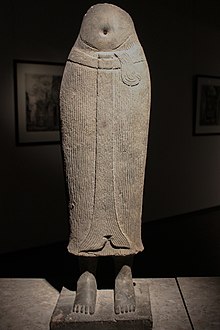Sampot

A sampot (
Origins
The Sampot dates back to the
Complex methods and intricate patterns have been developed to make the cloth, one of which is the hol method which involves dyeing patterns on silk before weaving. What remains unique to Cambodian weavers is the uneven twill technique. The reason they adopted such an unusual method remains unclear.[5]
However, little is known about the
-
11th century Khmer statue wearingsampot samloy, Guimet Museum, Paris
-
Sampot Samloy
-
9-10th century Khmer statue wearing another design of sampot
-
Folded sampot
Textiles
There are three important silk textiles in Cambodia. They include the ikat silks (chong kiet in Khmer), or hol, the twill-patterned silks and the weft ikat textiles.[
Traditionally, five colors are used, predominantly red, yellow, green, blue and black.[citation needed] The Sompot Hol is used as a lower garment and as the sompot chang kben. The Pidan Hol is used as a ceremonial hanging used for religious purposes.
Variations
There are many variations of the sampot, each is worn according to class. The typical regular sampot, known also as the sarong is typically worn by men and women of lower class. It measures approximately one and a half meters and both ends are sewn together. It is tied to secure it on the waist.[citation needed]
- The Sampot Phamuong សំពត់ផាមួង /sɑmpʊət pʰaa muəŋ/ designsdraw inspiration from ancient patterns on old silk.
- The Sampot Hol សំពត់ហូល /sɑmpʊət hool/ [8] is a typical traditional textile. There are two kinds of Sampot Hol, one is a wrapping skirt that uses a technique called chang kiet and twill weave. Influenced by the Indian patola, it developed patterns and techniques over the centuries to become a genuine Khmer art style. The sampot hol has over 200 patterns combined with three to five colors, yellow, red, brown, blue, and green. There are four variations, sampot hol, sompot hol por, sampot hol kben, and sampot hol ktong. Patterns are usually geometric motifs, animals, and flower motifs.
In daily life

The sompot is deeply rooted in Cambodia. Even though the French brought a degree of Westernization to Cambodia, Cambodians continued to wear the sompot. Royalty and government officials used the sampot chang kben with a formal jacket. The sompot chong kben and sompot phamuong are still worn by Cambodians today during special occasions, and rural and poor Khmers still prefer it over Western-style clothing for its comfort.
The material used by poor and rural Cambodians is not hand-woven silk but printed
See also
Further reading
- Gillian Green (2003). Traditional textiles of Cambodia. Bangkok: River Books. ISBN 974-8225-39-9.
References
- ^ "SEAlang Dictionary". www.sealang.net. Retrieved 2023-10-11.
- ^ Emma C. Bunker, Douglas Latchford. Adoration and glory: the golden age of Khmer art. Art Media Resources, 2004, p. 35
- ^ James C. Ingram. Economic change in Thailand 1850-1970. Stanford University Press, 1971, p. 10 By
- ^ a b Green, Gillian. "Textiles at the Khmer Court". Arts of Asia 30 (4): 82–92.
- ISBN 978-9744800749
- ISBN 978-1633232372
- ^ "SEAlang Dictionary". www.sealang.net. Retrieved 2023-10-11.
- ^ "SEAlang Dictionary". www.sealang.net. Retrieved 2023-10-11.






